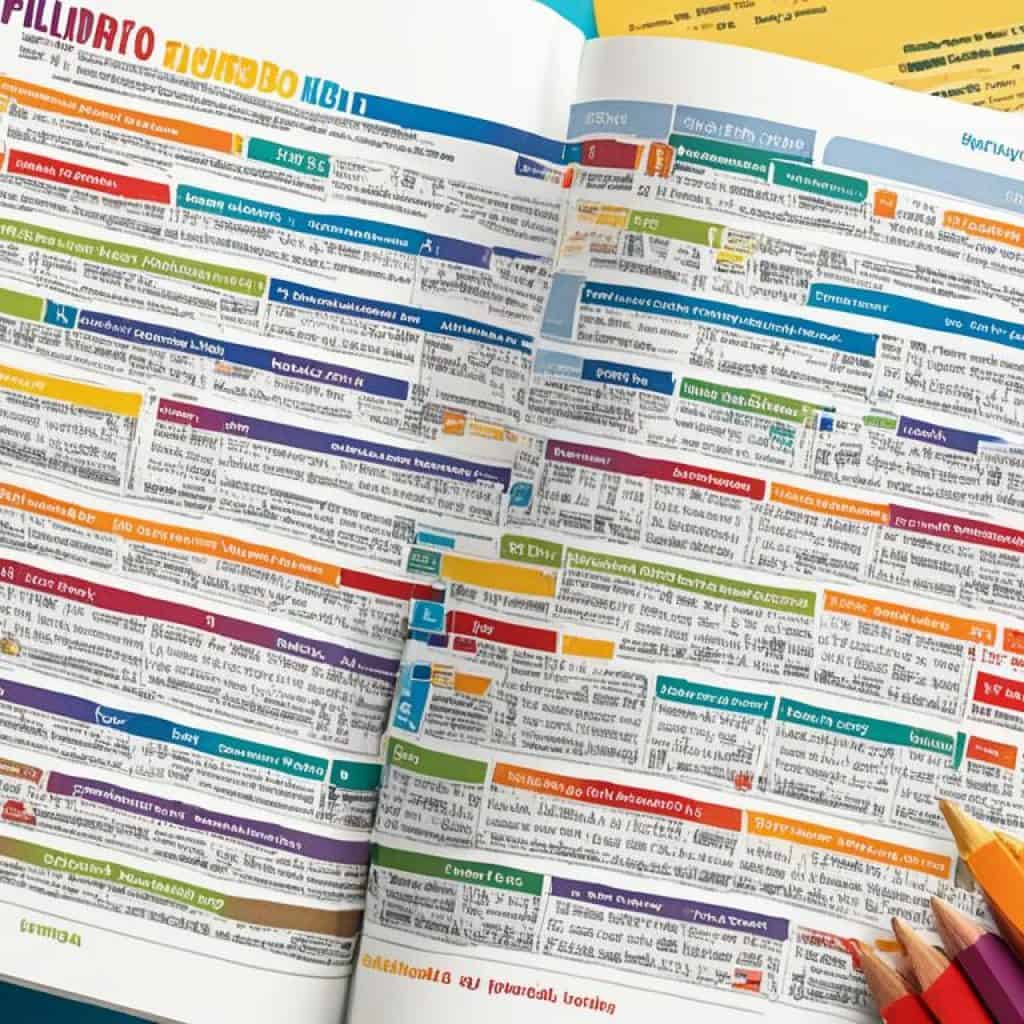Want to improve your language skills or visiting the Philippines soon? Learning common Filipino words and phrases is really helpful. It makes your trip better and helps you connect with local people. Knowing these words lets you communicate daily and respect the country’s culture.
We’ll guide you through Filipino language basics in this guide. You’ll learn tagalog phrases and popular Filipino expressions. Prepare to dive into the Philippines’ beautiful culture and explore its rich language diversity.
The Importance of Learning Tagalog
Tagalog, the national language of the Philippines, is widely spoken there. While many people also speak English, knowing Tagalog can make your trip better. It lets you chat easily and show respect for the local culture.
Learning Tagalog opens a window to the Filipino lifestyle. Knowing basic words and phrases helps you connect with locals. This leads to a deeper understanding of their ways and traditions.
Speaking Tagalog enhances your experience whether in Manila, Palawan, or Batanes. It shows you care about the culture and language. This can make your travels more special.
Learning Tagalog shows you’re open to new experiences. Locals will see your respect for their culture and be more helpful. Just a few Tagalog words can break the ice and build friendships.
“Learning a language is not just about conjugating verbs and memorizing vocabulary; it’s about connecting with people and immersing yourself in a rich cultural experience.”
The Benefits of Learning Tagalog
Learning basic Tagalog words lets you:
- Have better travel experiences by connecting with locals
- Easily chat about everyday things, like ordering food or getting directions
- Show you value Filipino culture
- Understand Filipino traditions and customs more deeply
- Make real friends with Filipino people
- Overcome language barriers and communicate better
Learning Tagalog is also rewarding. It makes you feel accomplished. Plus, it’s a way to learn something new and valuable.
If you’re visiting the Philippines for a short time or a long stay, learn some Tagalog. Use learning tools, practice with locals, and enjoy the Filipino language. Your efforts will lead to great memories and friendships.
The Diversity of Language in the Philippines
The Philippines is famous for having over 100 languages. Tagalog is the national language. But, many regional languages and dialects add to the country’s linguistic richness.
This variety in language reflects the nation’s varied history and multicultural mix. The Philippines had many colonizers, like Spain, the USA, and Japan. They influenced the languages spoken there.
Traditional Filipino terms and languages reveal each region’s unique identity. They highlight the rich cultural backgrounds and heritage of the people. By exploring these terms, you learn more about the Filipino culture and heritage.
The languages, like Cebuano and Ilocano, each tell a unique story. They carry a sense of pride and identity for the people. Embracing this diversity helps you understand the country better and connect with its people.
Discovering traditional Filipino languages is an exciting linguistic adventure. It helps in building cross-cultural understanding. Plus, it allows you to appreciate the nation’s diverse beauty more deeply.
Basic Tagalog Phrases for Beginners
Learning a few basic Tagalog phrases can make a big difference. Using them can improve your interactions with Filipino people. Here are some key phrases to start with:
Kamusta po kayo? – How are you?
Salamat po. – Thank you.
Oo. – Yes.
Hindi. – No.
Paumanhin. – Excuse me.
Sa’n po ang banyo? – Where is the bathroom?
These phrases are great for daily conversations. They show you’re trying to connect with local people. Practice these basic Filipino phrases. You’ll see how they help you communicate better in the Philippines.

Travel Situations
When you travel, having some phrases ready can be very helpful. Here are some Tagalog phrases for various situations:
- Magkano ito? – How much is this?
- Tulungan mo ako. – Help me.
- Pwede bang magpa-picture? – Can I take a picture?
- Ang ganda! – It’s beautiful!
Using these phrases can make your trip more fun. It also shows respect for the locals you meet.
Exploring Filipino Pronouns
Pronouns are key in any language, Filipino included. They are called “panghalip” here. These words take the place of nouns to help us talk better. By knowing and using Filipino pronouns right, you can talk better and more clearly.
There are different types of Filipino pronouns, each with its own role. Let’s dive into the main kinds:
- Personal Pronouns: These pronouns are about specific people. They show who is speaking, who is being spoken to, and who is being talked about. In Filipino, these include “ako” (I), “ka” (you), “siya” (he/she), “kami” (we), and “sila” (they).
- Demonstrative Pronouns: These pronouns highlight particular things. They can show how near or far something is. In Filipino, “ito” (this), “iyan” (that near you), and “iyon” (that far from us) are examples.
- Interrogative Pronouns: These pronouns ask questions. They’re useful for getting info or clarifying things. Filipino interrogative pronouns include “sino” (who), “ano” (what), “saan” (where), “kailan” (when), and “bakit” (why).
Getting good at Filipino pronouns will help you say what you mean clearly and understand others well. Feel confident using these pronouns as you get to know the Filipino language.
“Using the correct pronoun is essential for effective communication. Filipinos will appreciate your efforts to learn and use these pronouns correctly.”
Common Filipino Pronouns:
| Category | Examples |
|---|---|
| Personal Pronouns | ako (I) ka (you) siya (he/she) kami (we) sila (they) |
| Demonstrative Pronouns | ito (this) iyan (that near the listener) iyon (that far from both the speaker and listener) |
| Interrogative Pronouns | sino (who) ano (what) saan (where) kailan (when) bakit (why) |
Counting in Tagalog – Basic Numbers
Numbers are key in our daily lives, like telling time or shopping. Learning basic numbers in Tagalog will improve your understanding of Filipino. Here’s how to count from 1 to 10 in Tagalog:
| Tagalog Number | English Translation |
|---|---|
| Isa | One |
| Dalawa | Two |
| Tatlo | Three |
| Apat | Four |
| Limang | Five |
| Anim | Six |
| Pito | Seven |
| Walo | Eight |
| Siyam | Nine |
| Sampu | Ten |
With these numbers, you can communicate better and connect with Filipino culture. Knowing how to count in Tagalog is a key step if you’re learning the language. It’s helpful whether you’re traveling or just want to grow personally.
Essential Filipino Nouns
Nouns form the core of any language. In Filipino, we call them “pangngalan.” Knowing important Filipino nouns helps you speak well in many settings. Let’s dive into some Filipino nouns about family, food, and places.
Family Nouns
Family is very important in the Filipino culture. To fit in, learn nouns related to family. Here are some:
| Filipino Noun | English Translation |
|---|---|
| pamilya | family |
| ina | mother |
| ama | father |
| kapatid | sibling |
| lola | grandmother |
| lolo | grandfather |
Food Nouns
Filipino food is famous for its bold tastes and varied ingredients. Get to know these food-related nouns:
| Filipino Noun | English Translation |
|---|---|
| pagkain | food |
| kanin | rice |
| karne | meat |
| isda | fish |
| prutas | fruit |
| tinapay | bread |
Place Nouns
Learn these place-related nouns to find your way in Filipino cities and landmarks. Check out these examples:
| Filipino Noun | English Translation |
|---|---|
| tindahan | store |
| simbahan | church |
| eskuwela | school |
| parke | park |
| palengke | market |
| bayan | town |
Knowing these essential Filipino nouns is a big step towards being able to communicate confidently in Tagalog.
Verbs in Tagalog
Verbs, or “pandiwa” in Filipino, are key for talking about actions and events. They let us build sentences that make sense in Tagalog. Learning Tagalog verbs helps you make better sentences and talk more confidently.
Tagalog verbs are flexible, letting you describe various actions and feelings. You can talk about doing something, how you feel, or what’s happening around you. These verbs are crucial for clear and effective chatting.
Here are some common Tagalog verbs:
- Lakad (to walk)
- Kanta (to sing)
- Kain (to eat)
- Tulog (to sleep)
- Sulat (to write)
- Tanong (to ask)
These verbs are just a start. As you learn more Tagalog, you’ll find many more verbs. They will grow your vocabulary and improve how you communicate.
Use these verbs in sentences often to better understand them. The more you practice, the easier it gets to express yourself in Tagalog.

Adjectives in Tagalog
Adjectives, or pang-uri in Filipino, describe nouns. They add detail and color to our conversations. Knowing how to use Tagalog adjectives lets you describe people, places, and emotions better.
Let’s look at some common Filipino adjectives:
| English | Tagalog | Pronunciation | Example Sentence |
|---|---|---|---|
| Beautiful | Maganda | Mah-GAHN-dah | Ang magandang babae – The beautiful woman |
| Big | Malaki | Mah-LAH-ki | Ang malaking bahay – The big house |
| Happy | Maligaya | Mah-lee-GAH-yah | Ang maligayang pamilya – The happy family |
| Delicious | Masarap | Mah-SAH-rap | Ang masarap na pagkain – The delicious food |
| Hot | Mainit | Mahy-neeht | Ang mainit na kape – The hot coffee |
These adjectives are a great way to begin expanding your Tagalog. To make your language skills stronger, practice these words in real conversations. Always pair the right adjective with its noun for more vivid and accurate sentences.
Conjunctions in Tagalog
Conjunctions, or “pangatnig” in Filipino, link words, phrases, or sentences together. They make your speech flow better. Here’s a list of common Filipino conjunctions:
- At – and
- O – or
- Pero – but
- Kaya – so
- Dahil – because
- Ngunit – however
- Pagkatapos – after
- Samantalang – while
“Halika, at sasamahan kita.”
“Come, and I will accompany you.”
Filipino conjunctions have different roles. They help in joining thoughts or showing contrast. Using them right will improve your communication.
Remember, there’s a wide variety of Filipino conjunctions. Try different ones to grow your vocabulary and skills.
Common Filipino Expressions
Filipino culture is known for its colorful expressions and idioms. These reflect the country’s rich history and diverse influences. Learning common Filipino expressions can help you communicate better. It also deepens your understanding of the local culture. Here are a few examples:
- Maganda – This is a widely used word in Filipino, meaning “beautiful” or “good.” It’s used to describe things that are appreciated or appealing.
- Salamat – Meaning “thank you” in Filipino, this word is essential for expressing gratitude. Saying “salamat” is polite when someone has helped you or been kind.
- Pakikisama – This expression highlights the value of harmony with others. It stresses the importance of unity, cooperation, and social harmony.
- Bahala na – Used to show the Filipino spirit of resilience and adaptability. It translates roughly to “leave it to fate” or “come what may.” It shows a willingness to accept any outcome.
- Kamusta – The Filipino way of saying “how are you?” It’s a common greeting. It’s a good way to start a conversation and show interest in someone’s well-being.
Learning these expressions can improve your language skills and help you connect with Filipinos. Using these phrases makes locals feel comfortable and shows your interest in their culture.
So, if you’re planning a trip to the Philippines or just want to learn more, get to know common Filipino expressions. It’s a great way to bridge cultural gaps and forge meaningful connections.
Further Resources for Learning Filipino
If you’re eager to deepen your understanding of the Filipino language, a variety of resources can help you. These resources offer chances to practice and grow your Tagalog skills. You can choose from online platforms, language courses, and exchange programs, depending on what fits you best.
Online Platforms
Online platforms are an interactive and easy way to learn Filipino at your pace. They offer lessons, exercises, and quizzes for all skill levels. Some top platforms for learning Filipino include:
- Duolingo: A user-friendly app that offers gamified lessons and personalized learning experiences for free.
- Rosetta Stone: A language learning software that provides an immersive learning environment.
- Babbel: An online platform focusing on practical conversations and real-life scenarios.
Language Courses
Structured language courses give a full learning experience and connect you with qualified teachers. You can pick in-person classes or virtual lessons. Below are some places you can look into for learning Filipino:
- Universities or Community Colleges: They often have Filipino language courses in their foreign language programs.
- Language Schools: These schools offer specialized Filipino courses for different levels.
- Online Language Courses: There are many virtual courses taught by experienced Filipino language instructors.
Language Exchange Programs
Joining language exchange programs is a great way to practice Filipino with native speakers. You can find partners who want to learn your language in exchange. Check out these platforms for language exchange:
- Tandem: This app connects learners globally for mutual language practice.
- ConversationExchange: Find language exchange partners by interests and skill levels.
- Meetup: Join Filipino language or cultural groups locally to meet native speakers and other learners.
Remember, regular practice and diving into the language are crucial to mastering Filipino. By using these resources and immersing yourself, you’ll improve quickly.
Conclusion
Learning common Filipino words is an amazing journey. It helps you dive into the vibrant Filipino culture. This enhances your travel experiences greatly.
By learning basic Filipino phrases, pronouns, numbers, and nouns, you talk better with locals. This way, you’ll appreciate the Filipino language more. You’ll understand the people and their ways of life better.
Are you planning a trip to the Philippines? Or, do you want to improve your language skills? Learning Filipino can open new doors for you. It lets you connect with locals in a special way. You can also explore the rich history and culture of the country easily.
Begin your language learning journey today. See the beauty of learning Filipino. It’s a window into understanding the Philippines and its lovely people deeper.







Add comment